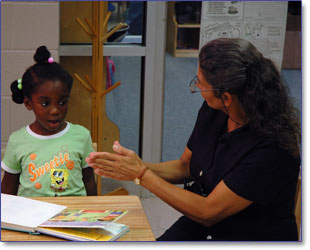|
 How to Teach Phonological Awareness How to Teach Phonological Awareness
There
are many activities that you can implement in a
preschool classroom that will promote the development
of children’s phonological awareness.
Calling children’s attention to the way language
sounds can happen in many different ways.
Choosing the most important skills on which
to focus is critical. It’s best to begin
with skills that children can master quickly
and that call their attention to the way words
sound, separate from their meanings. These skills,
such as combining words to make a compound word,
combining syllables to form a word, and combining
an onset
and a rime to form a word are the easiest
skills for most young children to acquire. The
onset of a word is the first consonant of a
word. The rime is the vowel and what follows
the vowel in that syllable. In the word bike,
the onset is “b” and the rime is “ike”.
When you rhyme words, the rime of the word
is usually included.
Later in the school year, as children master
these easier skills, it is important to work on
more rhyming activities, recognizing and matching
the beginning sounds in words, and blending sounds
to form short words.
It is important to plan fun and engaging activities
that will, at the same time, ensure that children
acquire these key skills. In general, 10 to
20 minutes of phonological awareness instruction
per day is sufficient. It’s best to divide
this time among many short activities than to
expect children to stay engaged for a 20-minute
lesson. To ensure that children have the opportunity
to practice skills and that the teacher can
monitor each child’s progress, it’s
a good idea to do much of this teaching with
small groups of children.
If, by the end of the school year, your students
can do the following, they will have a strong
foundation for learning to decode words in kindergarten:
- Combine words to make compound words and
delete a word from a compound word.
- Combine syllables to make words and delete
a syllable from a word.
- Combine word parts (onset and rime) to form
a familiar one-syllable word.
Correct Pronunciation of Sounds
One of the most important factors in teaching
letter sounds is the way the teacher pronounces
each sound. We teach children letter sounds so
that they can use those sounds to read words.
When children are reading words, they must be
able to blend the sounds together to form words.
|
- What are some of the phonological awareness activities that you would use with children at the beginning of the year?

- What are some phonological awareness activities that you would use with children at the middle and end of the year?

|
|